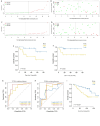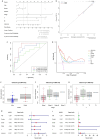[A risk scoring model based on M2 macrophage-related genes for predicting prognosis of HBV-related hepatocellular carcinoma]
- PMID: 38862440
- PMCID: PMC11166709
- DOI: 10.12122/j.issn.1673-4254.2024.05.04
[A risk scoring model based on M2 macrophage-related genes for predicting prognosis of HBV-related hepatocellular carcinoma]
Abstract
Objective: To investigate the prognostic value of M2 macrophage-related genes (MRG) in hepatitis B virus (HBV)- related hepatocellular carcinoma (HCC).
Methods: The transcriptome data of 73 patients with HBV-related HCC were obtained from TCGA database, and the MRG modules were identified by WGCNA. The MRG-based risk scoring model was constructed by LASSO regression analysis and validated using an external dataset. The correlation of the risk score with immune cell infiltration and drug sensitivity of HCC were analyzed with CIBERSORT and R. pRRophetic. The signaling pathways of the differential genes between the high- and low-risk groups were investigated using GSVA and GSEA enrichment analyses, and MRG expressions at the single cell level were validated using R.Seurat. The cell interaction intensity was analyzed by R.Cellchat to identify important cell types related to HCC progression. MRG expression levels were detected by RT-qPCR in THP-1 cells with HCC-conditioned medium-induced M2 polarization and in HBV-positive HCC cells.
Results: A high M2 macrophage infiltration level was significantly correlated with a poor prognosis of HCC, and 5 hub MRG (VTN, GCLC, PARVB, TRIM27, and GMPR) were identified. The overall survival of HCC patients was significantly lower in the high-risk than in the low-risk group. The high- and the low-risk groups showed significant enrichment of M2 macrophages and na?ve B cells, respectively, and were sensitive to BI. 2536 and to AG. 014699, AKT. inhibitor. Ⅷ, AZD. 0530, AZD7762, and BMS. 708163, respectively. The proliferation-related and metabolism-related pathways were enriched in the high-risk group, where monocytes showed the most active cell interactions during HCC progression. VTN was significantly upregulated in HCC cell lines, while GCLC, PARVB, TRIM27, and GMPR were upregulated in M2 THP-1 cells.
Conclusion: The MRG-based risk scoring model can accurately predict the prognosis of HBV-related HCC and reveal the differences in tumor microenvironment to guide precision treatment of the patients.
目的: 探讨在乙型肝炎病毒(HBV)相关肝细胞癌(HCC)中M2巨噬细胞特征基因(MRG)对患者预后的评估价值及潜在的分子机制。
方法: 从TCGA数据库获取73例HBV相关肝HCC患者的转录组数据,通过WGCNA识别M2巨噬细胞相关基因模块,利用LASSO鉴定出关键MRG并构建风险评分,并在外部数据集中验证风险评分的预测性能。应用CIBERSORT和R.pRRophetic分析风险评分与免疫细胞浸润、药物敏感性的关系。通过GSVA和GSEA对高风险组和低风险组的差异基因进行通路富集分析。R.Seurat验证在HCC中表达MRG的细胞类型,并通过R.Cellchat分析细胞互作强度,找到与HCC进展相关的重要细胞类型。流式细胞术检测肝癌条件培养基诱导THP-1向M2样极化,RT-qPCR验证MRG在HBV阳性的肝癌细胞系和M2巨噬细胞中表达。
结果: M2巨噬细胞高浸润状态与患者不良预后显著相关(P=0.025)。高风险组的总生存期(OS)均显著低于低风险组(训练集P=0.021,测试集P=0.046)。高风险组中M2巨噬细胞显著富集(P=0.03),低风险组中幼稚B细胞显著富集(P=0.049)。药物BI.2536对高风险组更有效(P=0.025),AG.014699(P=0.044)、AKT.inhibitor.VIII(P=0.041)、AZD.0530(P=0.0033)、AZD7762(P=0.0051)和BMS.708163(P=0.015)对低风险组更有效。通路富集分析结果表明,增殖相关通路和代谢相关通路在高风险组中富集。单核细胞在高风险组HCC进展的细胞互作中最为活跃。VTN在PLC/PRF/5中的表达显著上调(P<0.0001),GCLC、PARVB、TRIM27和GMPR在M2样THP-1中的表达显著上调(P=0.0037、P=0.0015、P=0.0071、P=0.0004)。
结论: MRG风险评分能准确预测HBV相关HCC患者的预后,揭示其肿瘤微环境的差异,为HCC患者的精准治疗提供了指导。
Keywords: M2 macrophages; hepatitis B virus; hepatocellular carcinoma; prognostic model.
Figures









Similar articles
-
Establishment of a prognostic signature based on fatty acid metabolism genes in HCC associated with hepatitis B.BMC Gastroenterol. 2023 Nov 13;23(1):390. doi: 10.1186/s12876-023-03026-5. BMC Gastroenterol. 2023. PMID: 37957550 Free PMC article.
-
Identification of Potential Hub Genes Related to Diagnosis and Prognosis of Hepatitis B Virus-Related Hepatocellular Carcinoma via Integrated Bioinformatics Analysis.Biomed Res Int. 2020 Dec 8;2020:4251761. doi: 10.1155/2020/4251761. eCollection 2020. Biomed Res Int. 2020. PMID: 33376723 Free PMC article.
-
Hepatitis B-related hepatocellular carcinoma: classification and prognostic model based on programmed cell death genes.Front Immunol. 2024 May 10;15:1411161. doi: 10.3389/fimmu.2024.1411161. eCollection 2024. Front Immunol. 2024. PMID: 38799437 Free PMC article.
-
Factors predicting occurrence and prognosis of hepatitis-B-virus-related hepatocellular carcinoma.World J Gastroenterol. 2011 Oct 14;17(38):4258-70. doi: 10.3748/wjg.v17.i38.4258. World J Gastroenterol. 2011. PMID: 22090781 Free PMC article. Review.
-
Hepatitis B viral load affects prognosis of hepatocellular carcinoma.World J Gastroenterol. 2014 Sep 14;20(34):12039-44. doi: 10.3748/wjg.v20.i34.12039. World J Gastroenterol. 2014. PMID: 25232241 Free PMC article. Review.
Cited by
-
Tumor-associated bacteria activate PRDX1-driven glycolysis to promote immune evasion and PD-1 antibody resistance in hepatocellular carcinoma.Front Microbiol. 2025 Jul 7;16:1599691. doi: 10.3389/fmicb.2025.1599691. eCollection 2025. Front Microbiol. 2025. PMID: 40693141 Free PMC article.
References
Publication types
MeSH terms
LinkOut - more resources
Full Text Sources
Medical
Miscellaneous
